Research on Mediating Mechanisms and the Impact on Food Provision Services in Poor Areas from the Perspective of Stakeholders
Abstract
:1. Introduction
- (1)
- What are the common demands and behavioral responses of stakeholders in food provision services in this region?
- (2)
- What are the relationships among the stakeholders in the region?
2. Study Area and Methods
2.1. Study Area
2.2. Methods
2.2.1. The Conceptual Framework of the Stakeholder Mediating Mechanism
2.2.2. Identification of Stakeholders
2.2.3. Determination of Demand and Behavior
2.2.4. Analysis of the Relationship among Stakeholders
2.3. Data Sources
3. Results
3.1. Analysis of Stakeholder Demands and Behaviors
3.1.1. Stakeholder Identification
3.1.2. Common Demands and Behavioral Responses of Stakeholders
3.2. Relationships among Stakeholders
3.3. Mediating Mechanisms and Affects
3.3.1. Types of Mediating Mechanisms
3.3.2. The Effects of Mediating Mechanisms
4. Discussion
4.1. The Importance of Research from the Perspective of Stakeholders
4.2. Regional Differences in Mediating Mechanisms and the Causes
4.3. Validation and Application Prospects of the Framework
4.4. Recommendations and Limitations of the Study
5. Conclusions
Supplementary Materials
Author Contributions
Funding
Institutional Review Board Statement
Informed Consent Statement
Data Availability Statement
Conflicts of Interest
References
- Zhang, H.Z.; Yang, Q.Y.; Zhang, Z.X.; Lu, D.; Zhang, H.M. Spatiotemporal changes of ecosystem service value determined by national land space pattern change: A case study of Fengdu county in the three gorges reservoir area, China. Int. J. Environ. Res. Public Health 2021, 18, 5007. [Google Scholar] [CrossRef]
- Amorim, J.H.; Engardt, M.; Johansson, C.; Ribeiro, I.; Sannebro, M. Regulating and cultural ecosystem services of urban green infrastructure in the nordic countries: A systematic review. Int. J. Environ. Res. Public Health 2021, 18, 1219. [Google Scholar] [CrossRef]
- Costanza, R. Social goals and the valuation of ecosystem services. Ecosystems 2000, 3, 4–10. [Google Scholar] [CrossRef]
- Reyers, B.; Biggs, R.; Cumming, G.S.; Elmqvist, T.; Hejnowicz, A.P.; Polasky, S. Getting the measure of ecosystem services: A social-ecological approach. Front. Ecol. Environ. 2013, 11, 268–273. [Google Scholar] [CrossRef] [Green Version]
- Bennett, E.M. Research frontiers in ecosystem service science. Ecosystems 2016, 20, 31–37. [Google Scholar] [CrossRef]
- Al-Ansari, T.; Korre, A.; Nie, Z.; Shah, N. Development of a life cycle assessment tool for the assessment of food production systems within the energy, water and food nexus. Sustain. Prod. Consum. 2015, 2, 52–66. [Google Scholar] [CrossRef]
- Purwanto, A.; Susnik, J.; Suryadi, F.X.; de Fraiture, C. Quantitative simulation of the water-energy-food (wef) security nexus in a local planning context in Indonesia. Sustain. Prod. Consum. 2020, 25, 198–216. [Google Scholar] [CrossRef]
- Sullivan, S.; Hossler, K.; Cianfrani, C.M. Ecosystem structure emerges as a strong determinant of food-chain length in linked stream–riparian ecosystems. Ecosystems 2015, 18, 1356–1372. [Google Scholar] [CrossRef]
- Schneider, A.; Logan, K.E.; Kucharik, C.J. Impacts of urbanization on ecosystem goods and services in the U.S. corn belt. Ecosystems 2012, 15, 519–541. [Google Scholar] [CrossRef]
- Xie, Y.C.; Gong, J.; Qi, S.S.; Zhang, Y.; Guo, J.J. Assessment of ecosystem food production and its spatiotemporal heterogeneity in the Bailong River Watershed Gansu. Acta Ecol. Sin. 2017, 37, 1719–1728. [Google Scholar]
- Bryan, B.A.; Grandgirard, A.; Ward, J.R. Quantifying and exploring strategic regional priorities for managing natural capital and ecosystem services given multiple stakeholder perspectives. Ecosystems 2010, 13, 539–555. [Google Scholar] [CrossRef]
- Fedele, G.; Locatelli, B.; Djoudi, H. Mechanisms mediating the contribution of ecosystem services to human well-being and resilience. Ecosyst. Serv. 2017, 28, 43–54. [Google Scholar] [CrossRef]
- Daw, T.M.; Coulthard, S.; Cheung, W.W.L.; Brown, K.; Abunge, C.; Galafassi, D.; Peterson, G.D.; McClanahan, T.R.; Omukoto, J.O.; Munyi, L. Evaluating taboo trade-offs in ecosystems services and human well-being. Proc. Natl. Acad. Sci. USA 2015, 112, 6949–6954. [Google Scholar] [CrossRef] [Green Version]
- Grindle, A.K.; Siddiqi, A.; Anadon, L.D. Food security amidst water scarcity: Insights on sustainable food production from saudi arabia. Sustain. Prod. Consum. 2015, 2, 67–78. [Google Scholar] [CrossRef]
- Tang, L.; Zhao, W.; Li, X. The deep logical analysis of global food security evaluation system. J. Huazhong Agric. Univ. 2020, 5, 51–60. [Google Scholar]
- Fan, S.; Zhang, Y.; Chen, K. Antiglobalism and global food security. Agric. Econ. Issues 2019, 3, 4–10. [Google Scholar]
- Unnevehr, L.; Hoffmann, V. Food safety management and regulation: International experiences and lessons for China. J. Integr. Agric. 2015, 14, 2218–2230. [Google Scholar] [CrossRef]
- Chen, H.; López-Carr, D.; Tan, Y.; Xi, J.; Liang, X. China’s grain for green policy and farm dynamics: Simulating household land-use responses. Reg. Environ. Chang. 2016, 16, 1147–1159. [Google Scholar] [CrossRef]
- Wu, C.; Zhang, J. Evolutionary game analysis of stakeholders in grain production. Stat. Decis. Mak. 2015, 22, 61–64. [Google Scholar]
- Bui, L.K.; Hoang, H. Non-farm employment, food poverty and vulnerability in rural Vietnam. Environ. Dev. Sustain. 2021, 23, 7326–7357. [Google Scholar] [CrossRef]
- Sambell, R.; Andrew, L.; Godrich, S.; Wolfgang, J.; Vandenbroeck, D.; Stubley, K.; Rose, N.; Newman, L.; Horwitz, P.; Devine, A. Local challenges and successes associated with transitioning to sustainable food system practices for a west australian context: Multi-sector stakeholder perceptions. Int. J. Environ. Res. Public Health 2019, 16, 2051. [Google Scholar] [CrossRef] [Green Version]
- Sanye-Mengual, E.; Orsini, F.; Gianquinto, G. Revisiting the sustainability concept of urban food production from a stakeholders’ perspective. Sustainability 2018, 10, 2175. [Google Scholar] [CrossRef] [Green Version]
- Johnson, B.J.; Zarnowiecki, D.; Hutchinson, C.L.; Golley, R.K. Stakeholder generated ideas for alternative school food provision models in Australia using the nominal group technique. Int. J. Environ. Res. Public Health 2020, 17, 7935. [Google Scholar] [CrossRef]
- Harvey, J. Stakeholder analysis applied to safety issues in food production: What are the issues in terms of trust and risks and their implications? A sample analysis. In Proceedings of the 19th International Scientific Conference on Agrarian Perspectives, Prague, Czech Republic, 14–15 September 2010; pp. 201–209. [Google Scholar]
- Irani, T.; Pierre, B.F.; Nesbit, T.S. Agricultural stakeholders’ perceptions of occupational health and safety in the southeastern U.S. Coastal States. Int. J. Environ. Res. Public Health 2021, 18, 6605. [Google Scholar] [CrossRef]
- Roth, M.; Frixen, M.; Tobisch, C.; Scholle, T. Finding spaces for urban food production matching spatial and stakeholder analysis with urban agriculture approaches in the urban renewal area of Dortmund-Horde, Germany. Future Food J. Food Agric. Soc. 2015, 3, 79–88. [Google Scholar]
- Smith, V.M.; Powell, M.; Mungeam, D.; Emmons, R.G. Stakeholder perceptions of the impact of cannabis production on the southern oregon food system. J. Agric. Food Syst. Community Dev. 2019, 8, 1–11. [Google Scholar] [CrossRef] [Green Version]
- Malinauskaite, L.; Cook, D.; Davísdóttir, B.; Ogmundardóttir, H. Socio-cultural valuation of whale ecosystem services in Skjálfandi bay, Iceland. Ecol. Econ. 2021, 180, 106867. [Google Scholar] [CrossRef]
- Freeman, R.E. Strategic Management: A Stakeholder Approach; Cambridge University Press: Pitman, Boston, MA, USA, 1984. [Google Scholar]
- Aini, A.; Halik, U.; Aishan, T.; Betz, F.; Abulizi, A.; Zhang, Q. Analysis of stakeholders’ cognition on desert riparian forest ecosystem services in the lower reaches of Tarim River, China. Res. Soil Water Conserv. 2016, 23, 205–209. [Google Scholar]
- Du, Q.; Yan, Y.; Huang, Y.; Hao, C.; Wu, J. Evolutionary games of low-carbon behaviors of construction stakeholders under carbon taxes. Int. J. Environ. Res. Public Health 2021, 18, 508. [Google Scholar] [CrossRef] [PubMed]
- Quevedo, J.M.D.; Uchiyama, Y.; Kohsaka, R. A blue carbon ecosystems qualitative assessment applying the DPSIRE framework: Local perspective of global benefits and contributions. Mar. Policy 2021, 128, 104462. [Google Scholar] [CrossRef]
- Ehara, M.; Hyakumura, K.; Sato, R.; Kurosawa, K.; Araya, K.; Sokh, H.; Kohsaka, R. Addressing maladaptive coping strategies of local communities to changes in ecosystem service provisions using the dpsir framework. Ecol. Econ. 2018, 149, 226–238. [Google Scholar] [CrossRef]
- Ranngen, H. Stakeholder management in reality: Moving from conceptual frameworks to operational strategies and interactions. Sustain. Prod. Consum. 2015, 3, 21–33. [Google Scholar] [CrossRef]
- Jagtap, S.S.; Jones, J.W.; Hildebrand, P.E.; Letson, D.; O’Brien, J.J.; Podestá, G.; Zierden, D.; Zazueta, F. Responding to stakeholder’s demands for climate information: From research to applications in Florida. Agric. Syst. 2002, 74, 415–430. [Google Scholar] [CrossRef]
- Garland, A.F.; Lewczyk-Boxmeyer, C.M.; Gabayan, E.N.; Hawley, K.M. Multiple stakeholder agreement on desired outcomes for adolescents’ mental health services. Psychiatr. Serv. 2004, 55, 671–676. [Google Scholar] [CrossRef] [PubMed]
- Throuvala, M.A.; Griffiths, M.D.; Rennoldson, M.; Kuss, D.J. Recommendations for public policy and prevention of problematic online behaviours: A multi-stakeholder perspective and the common denominator. J. Behav. Addict. 2019, 8, 123. [Google Scholar]
- Asah, S.T.; Blahna, D.J. Involving stakeholders’ knowledge in co-designing social valuations of biodiversity and ecosystem services: Implications for decision-making. Ecosystems 2020, 23, 324–337. [Google Scholar] [CrossRef]
- Palacios-Agundez, I.; de Manuel, B.F.; Rodriguez-Loinaz, G.; Pena, L.; Ametzaga-Arregi, I.; Alday, J.G.; Casado-Arzuaga, I.; Madariaga, I.; Arana, X.; Onaindia, M. Integrating stakeholders’ demands and scientific knowledge on ecosystem services in landscape planning. Landsc. Ecol. 2014, 29, 1423–1433. [Google Scholar] [CrossRef]
- Hahn, T. Reciprocal stakeholder behavior: A motive-based approach to the implementation of normative stakeholder demands. Bus. Soc. 2015, 54, 9–51. [Google Scholar] [CrossRef]
- Hosseininia, G.; Khachak, P.R.; Nooripoor, M.; Van Passel, S.; Azadi, H. Understanding communicational behavior among rangelands’ stakeholders: Application of social network analysis. J. Environ. Plan. Manag. 2015, 59, 1–22. [Google Scholar] [CrossRef]
- Lienert, J.; Schnetzer, F.; Ingold, K. Stakeholder analysis combined with social network analysis provides fine-grained insights into water infrastructure planning processes. J. Environ. Manag. 2013, 125, 134–148. [Google Scholar] [CrossRef] [Green Version]
- Statistics Bureau of Mizhi County (SBMC). Statistics for National Economic in Mizhi County; Statistics Bureau of Mizhi County: Mizhi, China, 2018.
- Zhang, H.; Chen, H.; Geng, T.; Liu, D.; Shi, Q. Evolutionary characteristics and trade-offs’ development of social–ecological production landscapes in the loess plateau region from a resilience point of view: A case study in Mizhi County, China. Int. J. Environ. Res. Public Health 2020, 17, 1308. [Google Scholar] [CrossRef] [Green Version]
- Liu, D.; Liang, X.Y.; Chen, H.; Zhang, H.; Mao, N.Z. A quantitative assessment of comprehensive ecological risk for a loess erosion gully: A case study of Dujiashi Gully, Northern Shaanxi Province, China. Sustainability 2018, 10, 3239. [Google Scholar] [CrossRef] [Green Version]
- Shi, Q.; Chen, H.; Liang, X.; Zhang, H.; Liu, D. Cultural ecosystem services valuation and its multilevel drivers: A case study of Gaoqu township in Shaanxi province, China. Ecosyst. Serv. 2020, 41, 101052. [Google Scholar] [CrossRef]
- Shi, Q.; Chen, H.; Liu, D.; Zhang, H.; Geng, T.; Zhang, H. Exploring the linkage between the supply and demand of cultural ecosystem services in loess plateau, China: A case study from Shigou Township. Environ. Sci. Pollut. Res. 2020, 27, 12514–12526. [Google Scholar] [CrossRef]
- Duggan, D.E.; Farnsworth, K.D.; Kraak, S. Identifying functional stakeholder clusters to maximise communication for the ecosystem approach to fisheries management. Mar. Policy 2013, 42, 56–67. [Google Scholar] [CrossRef]
- Mainardes, E.W. Identifying university stakeholders. Rev. Educ. 2012, 362, 375. [Google Scholar]
- Rizzo, E.; Pesce, M.; Pizzol, L.; Alexandrescu, F.M.; Giubilato, E.; Critto, A.; Marcomini, A.; Bartke, S. Brownfield regeneration in Europe: Identifying stakeholder perceptions, concerns, attitudes and information needs. Land Use Policy 2015, 48, 437–453. [Google Scholar] [CrossRef]
- Omondiagbe, H.A.; Towns, D.R.; Wood, J.K.; Bollard-Breen, B. Stakeholders and social networks identify potential roles of communities in sustainable management of invasive species. Biol. Invasions 2017, 19, 3037–3049. [Google Scholar] [CrossRef]
- Mannetti, L.M.; Gttert, T.; Zeller, U.; Esler, K.J. Identifying and categorizing stakeholders for protected area expansion around a national park in Namibia. Ecol. Soc. 2019, 24, 5–27. [Google Scholar] [CrossRef]
- Raum, S. A framework for integrating systematic stakeholder analysis in ecosystem services research: Stakeholder mapping for forest ecosystem services in the UK. Ecosyst. Serv. 2018, 29, 170–184. [Google Scholar] [CrossRef]
- Zhang, Y.; Xu, D.; Jia, Q. A study on the cooperative relationship between the ecotourism stakeholders in national parks: A case study of Gongyu zone in Xianju national park. Tour. Sci. 2017, 31, 51–64. [Google Scholar]
- Mitchell, A. Toward a theory of stakeholder identification and salience: Defining the principle of who and what Really Counts. Acad. Manag. Rev. 1997, 22, 853–886. [Google Scholar] [CrossRef]
- Zhang, X.; Gu, S.; Wang, X. Regional effects of mineral resources exploitation and impacts on stakeholders in Xinjiang. Resour. Sci. 2011, 33, 441–450. [Google Scholar]
- Sheehan, L.; Ritchie, J. Destination stakeholders: Exploring identity and salience. Ann. Tour. Res. 2005, 32, 711–734. [Google Scholar] [CrossRef]
- Li, F.; Zhen, L.; Huang, H.; Han, P.; Liu, X.; Jiang, L.; Wei, Y. Impacts of land use functional change on WTA and economic compensation for core stakeholders: A case study in Poyang Lake. Resour. Sci. 2009, 31, 580–589. [Google Scholar]
- Chabot, M.; Duhaime, G. Land-use planning and participation: The case of Inuit public housing (Nunavik, Canada). Habitat Int. 1998, 22, 429–447. [Google Scholar] [CrossRef]
- Wang, X.; Yu, Z.; Cinderby, S.; Forrester, J. Enhancing participation: Experiences of participatory geographic information systems in Shanxi province, China. Appl. Geogr. 2008, 28, 96–109. [Google Scholar] [CrossRef]
- Verweij, P.; Simoes, M.; Alves, A.; Ferraz, R.; Cormont, A. Linking bayesian belief networks and GIS to assess the ecosystem integrity in the brazilian Amazon. In Proceedings of the 7th International Environmental Modelling and Software Society (iEMSs), San Diego, CA, USA, 15–19 June 2014; Volume 2, pp. 864–871. [Google Scholar]
- Brescancin, F.; Dobinská, Z.; De Meo, I.; Šálka, J.; Paletto, A. Analysis of stakeholders’ involvement in the implementation of the natura 2000 network in slovakia. For. Policy Econ. 2017, 78, 107–115. [Google Scholar] [CrossRef]
- Yan, H.L.; Yu, J.; Xiong, H.; Wang, Q. Research on the network relationship of pro-poor tourism stakeholders in minority villages. Soft Sci. 2019, 33, 80–85. [Google Scholar]
- Xue, D.Q.; Lyu, Y.; Huang, J.; Ma, B. Urban poverty groups’ subjective life quality: A case study on Xi’an typical community. Sci. Geogr. Sin. 2017, 37, 554–562. [Google Scholar]
- Holst, R.; Yu, X.; Grün, C. Climate change, risk and grain yields in China. J. Integr. Agric. 2013, 12, 1279–1291. [Google Scholar] [CrossRef]
- Yao, C.S.; Li, Z.T.; Yi, X. Driving effects of grain production change and its spatial differences in China. China Population. Resour. Environ. 2016, 26, 72–81. [Google Scholar]
- Ramus, T.; Vaccaro, A.; Berrone, P. Author accepted manuscript: Time matters! how hybrid organizations use time to respond to divergent stakeholder demands. Organ. Stud. 2020, 42, 1529–1555. [Google Scholar] [CrossRef]
- Darvill, R.; Lindo, Z. The inclusion of stakeholders and cultural ecosystem services in land management trade-off decisions using an ecosystem services approach. Landsc. Ecol. 2016, 31, 533–545. [Google Scholar] [CrossRef]
- Waylen, K.A.; Young, J. Expectations and experiences of diverse forms of knowledge use: The case of the UK National Ecosystem Assessment. Environ. Plan. C Gov. Pract. 2014, 32, 229–246. [Google Scholar] [CrossRef] [Green Version]
- Fan, D.P. An analysis of the sustainability of socio-ecological systems from the perspective of complexity science. J. Dialectics Nat. 2019, 41, 77–82. [Google Scholar]
- Daw, T.M.; Brown, K.; Rosendo, S.; Pomeroy, R. Applying the ecosystem services concept to poverty alleviation: The need to disaggregate human well-being. Environ. Conserv. 2011, 38, 370–379. [Google Scholar] [CrossRef] [Green Version]
- Matzdorf, B.; Meyer, C. The relevance of the ecosystem services framework for developed countries’ environmental policies: A comparative case study of the US and EU. Land Use Policy 2014, 38, 509–521. [Google Scholar] [CrossRef]
- Alphandery, P.; Fortier, A. Can a territorial policy be based on science alone? The system for creating the Natura 2000 network in France. Sociol. Rural 2013, 41, 311–328. [Google Scholar] [CrossRef]
- Harrison, C.M.; Burgess, J.; Clark, J. Discounted knowledges: Farmers’ and residents’ understanding of nature conservation goals and policies. J. Environ. Manag. 1998, 54, 305–320. [Google Scholar] [CrossRef]
- Felipe-Lucia, M.R.; Martin-Lopez, B.; Lavorel, S.; Berraquero-Diaz, L.; Escalera-Reyes, J.; Comin, F.A. Ecosystem services flows: Why stakeholders’ power relationships matter. PLoS ONE 2015, 10, e0132232. [Google Scholar] [CrossRef] [Green Version]
- Ciftcioglu, C.G. Social preference-based valuation of the links between home gardens, ecosystem services, and human well-being in Lefke Region of North Cyprus. Ecosyst. Serv. 2017, 25, 227–236. [Google Scholar] [CrossRef]
- China Green Food Development Center: Agricultural Geographical Indication Announcement No. 1054. Available online: https://baike.baidu.com/item/%E7%B1%B3%E8%84%82%E5%B0%8F%E7%B1%B3/7815383?fr=Aladdin (accessed on 17 September 2021).
- Qin, Y.; Shi, X.; Li, X.; Yan, J. Geographical indication agricultural products, livelihood capital, and resilience to meteorological disasters: Evidence from kiwifruit farmers in China. Environ. Sci. Pollut. Res. 2021, 4, 1–16. [Google Scholar]
- Pamuku, H.; Sara, M.; Aytuar, S.; Sandk, M. The effects of local food and local products with geographical indication on the development of tourism gastronomy. Sustainability 2021, 13, 6692. [Google Scholar] [CrossRef]
- Kwon, K. Relationship among marks of geographical indication, buying satisfaction and wom’s effect in agricultural products. J. Brand Des. Assoc. Korea 2019, 17, 5–18. [Google Scholar]
- Stevance, A.S.; Bridgewater, P.; Louafi, S.; King, N.; Beard, T.D., Jr.; Van Jaarsveld, A.S.; Ofir, Z.; Kohsaka, R.; Jenderedijan, K.; Rosales Benites, M.; et al. The 2019 review of ipbes and future priorities: Reaching beyond assessment to enhance policy impact. Ecosyst. People 2020, 16, 70–77. [Google Scholar] [CrossRef] [Green Version]
- Zhan, S. Riding on self-sufficiency: Grain policy and the rise of agrarian capital in China. J. Rural. Stud. 2017, 54, 151–161. [Google Scholar] [CrossRef]
- Pla, B.; Ye, Z.; Nr, C.; Mkha, D. Responsibility-driven collective action in the context of rapid rural depopulation. J. Rural Stud. 2020, 75, 48–56. [Google Scholar]
- Li, Y.; Westlund, H.; Liu, Y. Why some rural areas decline while some others not: An overview of rural evolution in the world. J. Rural. Stud. 2019, 68, 135–143. [Google Scholar] [CrossRef]
- Brown, G.; Donovan, S. Escaping the national forest planning quagmire: Using public participation GIS to assess acceptable national forest use. J. For. 2013, 111, 115–125. [Google Scholar] [CrossRef] [Green Version]
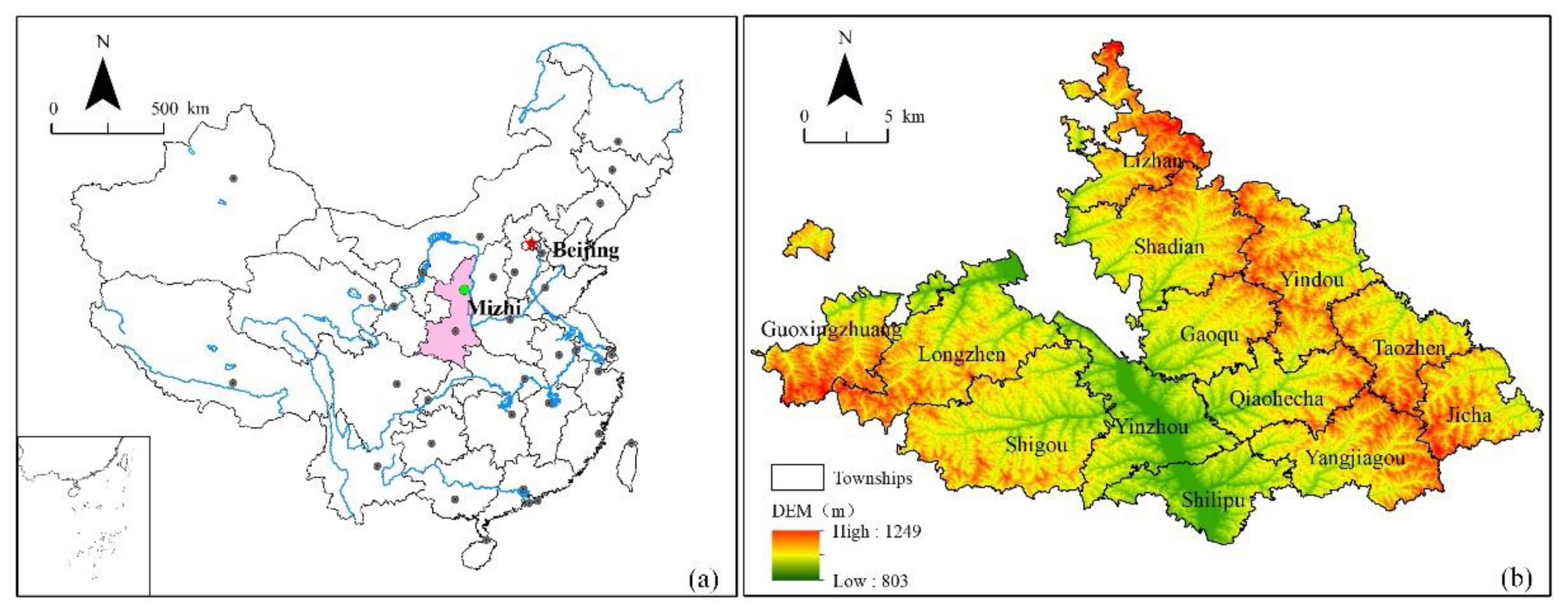
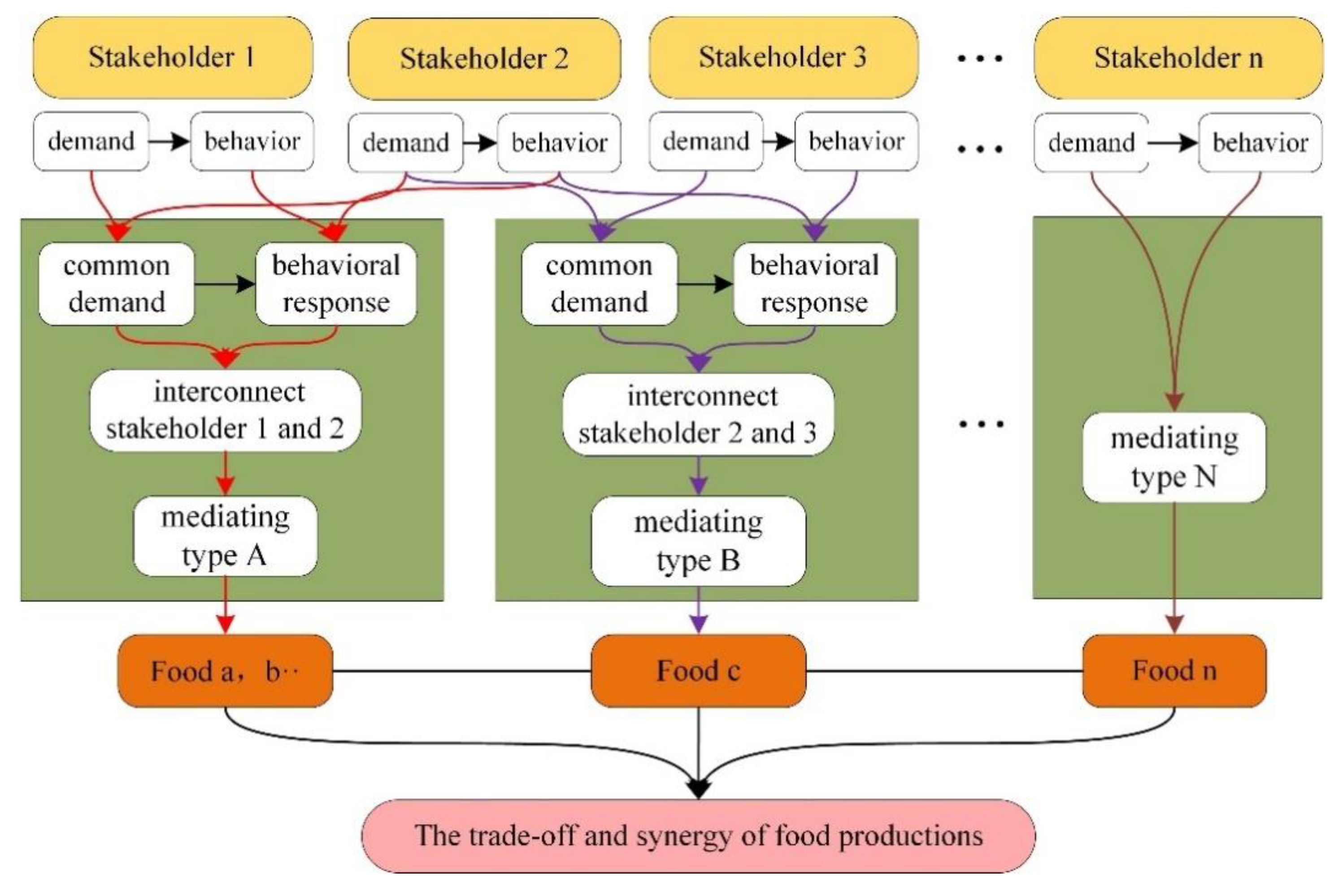
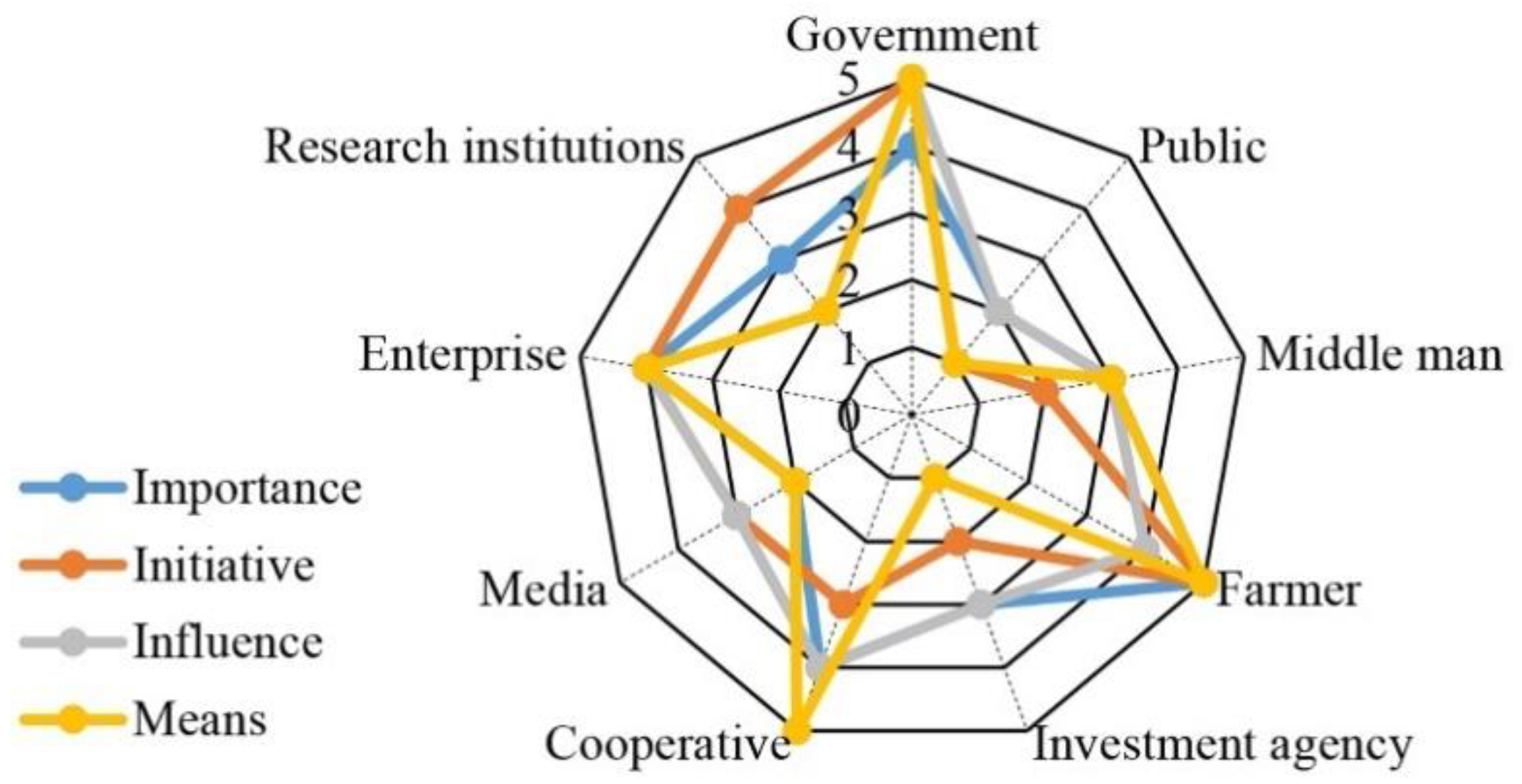
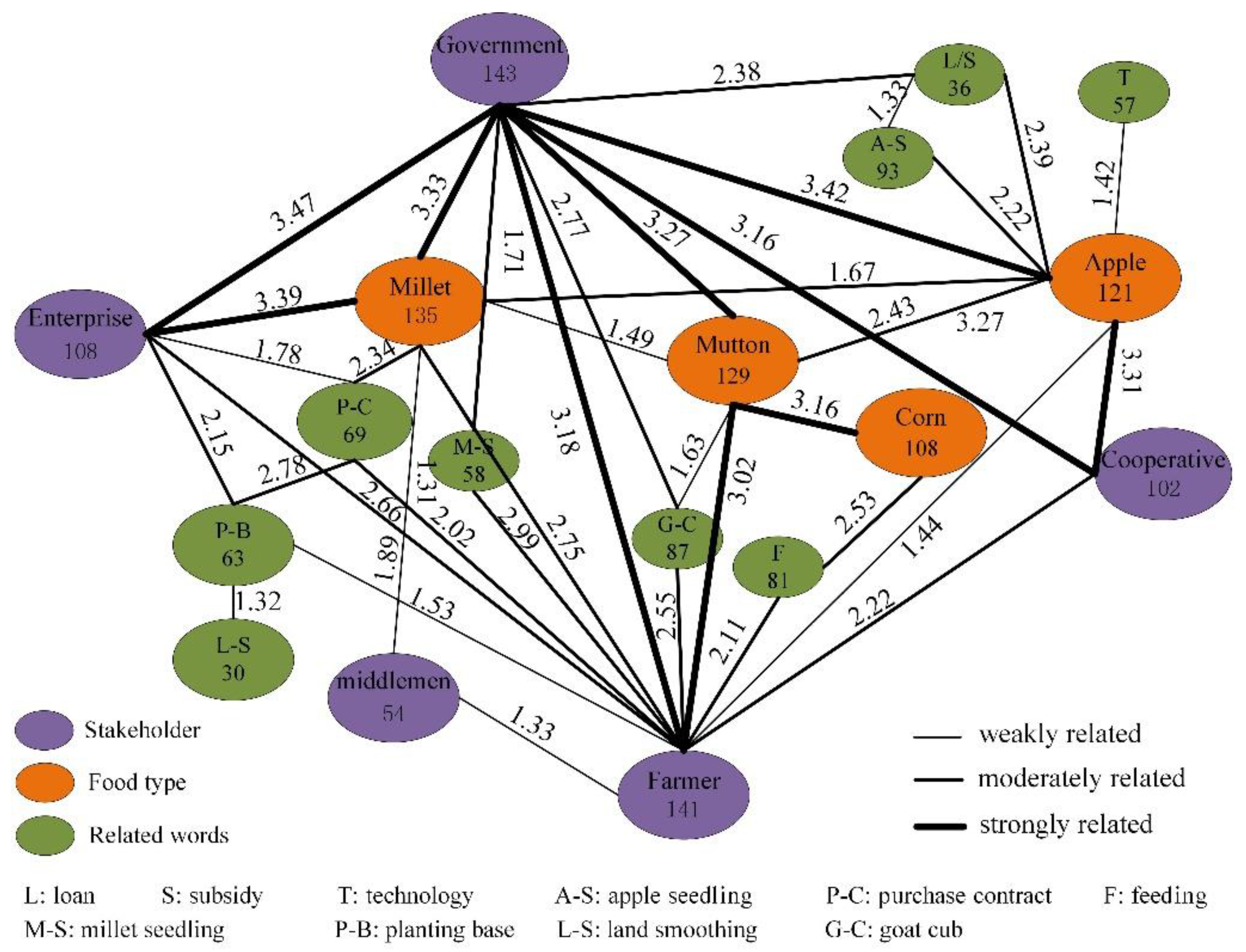

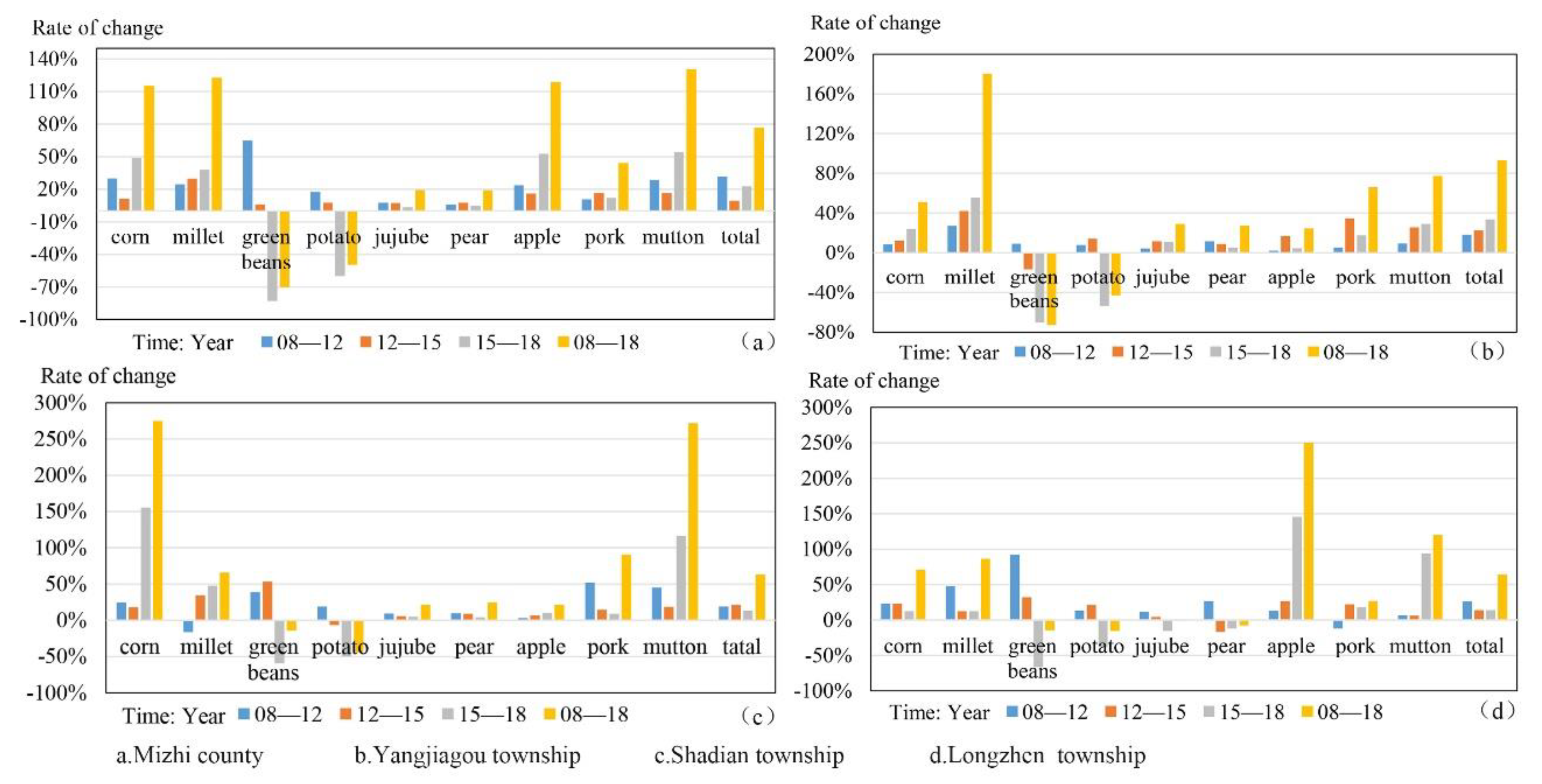
| Index | Index Description |
|---|---|
| Importance | The importance of different stakeholders in food production differs. Some stakeholders are essential in the process of food production, but the absence of others will not have a great impact on food production. |
| Initiative | Some stakeholders will take the initiative to exert influence on food production, while others are weak in initiative and even passively affected by food production. |
| Influence | The same behavior is performed by different stakeholders, but the results differ. Because the influence of different stakeholders is significantly different. |
| Means | Means can be divided into direct and indirect means. Direct refers to the behavior of stakeholders directly acting on the food production process; other behaviors are considered indirect means. |
| Stakeholders | Demands | Behavioral Response |
|---|---|---|
| Government | Increase farmers’ income, promote poverty alleviation, and ensure that the farmers who experience poverty alleviation do not return to poverty. | The government encourages farmers to change types of planting and breeding through a series of preferential policies: it provides free seeds and technology, promotes millet planting, and helps farmers establish purchasing relationships with enterprises, promotes apple growing and supports farmers with capital for apple growing, and provides goat kids to poor households and key villages to enable family breeding. |
| Farmers | Increase food production, raise food prices, increase personal and household incomes. | Change the structure of planting and breeding; abandon planting potato, green bean, and other crops, and plant millet. Some farmers grow apples with the support of the government. Many farmers raise goats as a family unit. At the same time, due to the shortage of goat feed, they also start to grow corn that can be used as goat feed. |
| Enterprises | Increase enterprise income, reduce food purchasing costs, fulfill social responsibilities and increase farmers’ income. | Establish a planting base to increase the purchase of millet, fulfill social responsibilities, establish purchasing relationships with farmers |
| Middleman | Increase the amount of food purchased; increase personal income. | Encourage farmers to switch to planting millet |
| Cooperatives | Increase the income of cooperatives, protect the interests of members, and increase members’ income. | Farmers grow apples with government subsidies and gradually transform from large planters to cooperatives, which employ farmers, pay them wages, and provide them with farming experience and technology |
| Corn | Millet | Green Bean | Potato | Jujube | Pear | Apple | Pork | Mutton | |
|---|---|---|---|---|---|---|---|---|---|
| corn | 1 | ||||||||
| Millet | 0.95 * | 1 | |||||||
| green bean | −0.63 * | −0.57 ** | 1 | ||||||
| Potato | −0.69 * | −0.57 ** | 0.96 * | 1 | |||||
| Jujube | 0.83 | 0.92 | −0.24 | −0.23 | 1 | ||||
| Pear | 0.87 | 0.97 | −0.41 | −0.38 | 0.98 * | 1 | |||
| Apple | 0.99 ** | 0.96 * | −0.69 | −0.73 | 0.82 | 0.28 * | 1 | ||
| Pork | 0.78 * | 0.78 * | −0.48 * | −0.44 | 0.96 | 0.95 | 0.91 | 1 | |
| Mutton | 0.99 ** | 0.97 * | −0.65 | −0.71 | 0.84 | 0.89 | 0.99 ** | 0.91 * | 1 |
Publisher’s Note: MDPI stays neutral with regard to jurisdictional claims in published maps and institutional affiliations. |
© 2021 by the authors. Licensee MDPI, Basel, Switzerland. This article is an open access article distributed under the terms and conditions of the Creative Commons Attribution (CC BY) license (https://creativecommons.org/licenses/by/4.0/).
Share and Cite
Geng, T.; Chen, H.; Liu, D.; Shi, Q.; Zhang, H. Research on Mediating Mechanisms and the Impact on Food Provision Services in Poor Areas from the Perspective of Stakeholders. Int. J. Environ. Res. Public Health 2021, 18, 10510. https://doi.org/10.3390/ijerph181910510
Geng T, Chen H, Liu D, Shi Q, Zhang H. Research on Mediating Mechanisms and the Impact on Food Provision Services in Poor Areas from the Perspective of Stakeholders. International Journal of Environmental Research and Public Health. 2021; 18(19):10510. https://doi.org/10.3390/ijerph181910510
Chicago/Turabian StyleGeng, Tianwei, Hai Chen, Di Liu, Qinqin Shi, and Hang Zhang. 2021. "Research on Mediating Mechanisms and the Impact on Food Provision Services in Poor Areas from the Perspective of Stakeholders" International Journal of Environmental Research and Public Health 18, no. 19: 10510. https://doi.org/10.3390/ijerph181910510
APA StyleGeng, T., Chen, H., Liu, D., Shi, Q., & Zhang, H. (2021). Research on Mediating Mechanisms and the Impact on Food Provision Services in Poor Areas from the Perspective of Stakeholders. International Journal of Environmental Research and Public Health, 18(19), 10510. https://doi.org/10.3390/ijerph181910510






